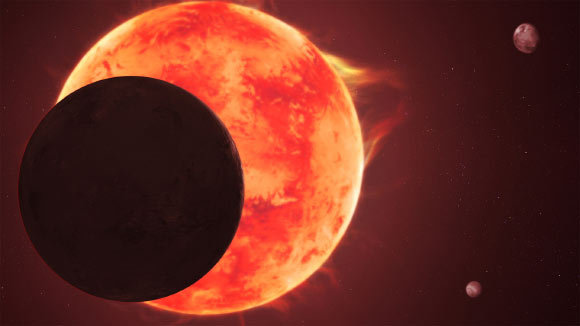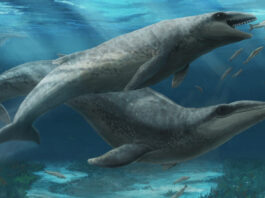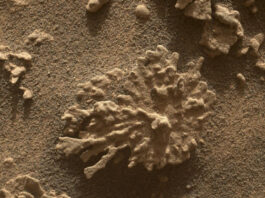A protective atmosphere, a friendly Sun, and lots of liquid water — Earth is a special place. Using the unprecedented capabilities of the NASA/ESA/CSA James Webb Space Telescope, astronomers are on a mission to determine just how special, and rare, our home planet is. Can this temperate environment exist elsewhere, even around a different type of star? The TRAPPIST-1 system provides a tantalizing opportunity to explore this question, as it contains seven Earth-sized worlds orbiting the most common type of star in the Milky Way — a red dwarf.

This artist’s concept depicts TRAPPIST-1d passing in front of its turbulent star, with other members of the closely packed system shown in the background. Image credit: NASA / ESA / CSA / Joseph Olmsted, STScI.
TRAPPIST-1 is an ultracool dwarf star in the constellation Aquarius, 38.8 light-years away.
The star is barely larger than Jupiter and has just 8% of our Sun’s mass. It is rapidly spinning and generates energetic flares of UV radiation.
TRAPPIST-1 is a home to seven transiting planets, named TRAPPIST-1b, c, d, e, f, g and h.
All these planets are similar in size to Earth and Venus, or slightly smaller, and have very short orbital periods: 1.51, 2.42, 4.04, 6.06, 9.21, 12.35 and 20 days, respectively.
They are likely all tidally locked, meaning the same face of the planet is always pointed at the star, as the same side of the Moon is always pointed at Earth. This creates a perpetual night side and perpetual day side on each TRAPPIST-1 planet.
“Ultimately, we want to know if something like the environment we enjoy on Earth can exist elsewhere, and under what conditions,” said Dr. Caroline Piaulet-Ghorayeb, an astronomer at the University of Chicago and Trottier Institute for Research on Exoplanets at the Université de Montréal.
“While Webb is giving us the ability to explore this question in Earth-sized planets for the first time, at this point we can rule out TRAPPIST-1d from a list of potential Earth twins or cousins.”
Dr. Piaulet-Ghorayeb and colleagues used Webb’s NIRSpec (Near-Infrared Spectrograph) instrument to obtain transmission spectra of the TRAPPIST-1d planet.
They did not detect molecules that are common in Earth’s atmosphere, like water, methane, or carbon dioxide.
However, they outlined several possibilities for the exoplanet that remain open for follow-up study.
“There are a few potential reasons why we don’t detect an atmosphere around TRAPPIST-1d,” Dr. Piaulet-Ghorayeb said.
“It could have an extremely thin atmosphere that is difficult to detect, somewhat like Mars.”
“Alternatively, it could have very thick, high-altitude clouds that are blocking our detection of specific atmospheric signatures — something more like Venus.”
“Or, it could be a barren rock, with no atmosphere at all.”
No matter what the case may be for TRAPPIST-1d, it’s tough being a planet in orbit around a red dwarf star.
TRAPPIST-1, the host star of the system, is known to be volatile, often releasing flares of high-energy radiation with the potential to strip off the atmospheres of its small planets, especially those orbiting most closely.
Nevertheless, scientists are motivated to seek signs of atmospheres on the TRAPPIST-1 planets because red dwarf stars are the most common stars in our Galaxy.
If planets can hold on to an atmosphere here, under waves of harsh stellar radiation, they could, as the saying goes, make it anywhere.
“Webb’s sensitive infrared instruments are allowing us to delve into the atmospheres of these smaller, colder planets for the first time,” said Dr. Björn Benneke, an astronomer with Trottier Institute for Research on Exoplanets at the Université de Montréal.
“We’re really just getting started using Webb to look for atmospheres on Earth-sized planets, and to define the line between planets that can hold onto an atmosphere, and those that cannot.”
The results appear in the Astrophysical Journal.
_____
Caroline Piaulet-Ghorayeb et al. 2025. Strict Limits on Potential Secondary Atmospheres on the Temperate Rocky Exo-Earth TRAPPIST-1d. ApJ 989, 181; doi: 10.3847/1538-4357/adf207



